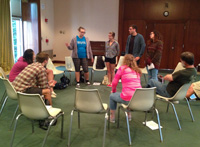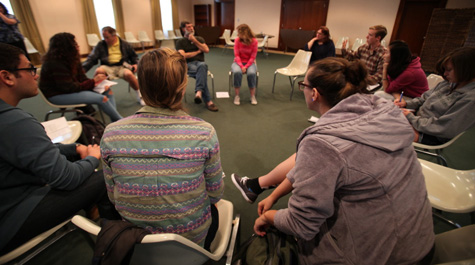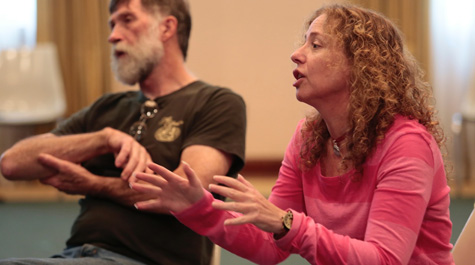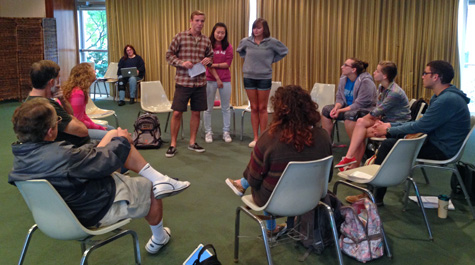W&M students collaborate with CW storytellers on ‘Highland Tales’
It’s a partnership tale worth the telling.
Two Colonial Williamsburg storytellers are teaming up with William & Mary theatre students this semester to develop a storytelling program that will debut at the DeWitt Wallace Decorative Arts Museum’s Hennage Auditorium in December.
{{youtube:medium|U5huzECuUak}}
Donna Wolf and Shel Browder have been working with students in Professor Laurie Wolf’s “Survey of Theatre History: 1750 to the Present” course to create and fine-tune the “Rum and Highland Tales” program, which will include 18th-century Gaelic stories. Although many stories have been told on the W&M Theatre stage and in Colonial Williamsburg throughout the years, this is the first time that the neighboring organizations have collaborated on such a project.
Browder and Donna, who have years of storytelling experience, originally approached Laurie, director of theatre, for her assistance with their new program. The storytellers asked about the possibility of bringing students into the process, and the W&M professor suggested her THEA 329 class, which is mostly comprised of theatre majors.
The collaboration would give the storytellers a chance to get the feedback they needed, and it would also give students an opportunity to learn about storytelling, something that is not covered in many theatre classes, said Laurie.
Always the observer
Although storytelling and theatre may seem very similar, storytellers are always observers, said Donna.
“You’re not in the story; you’re outside of the story relating it to people, so it’s a different viewpoint,” said Browder.
“[In theatre], the script drives the story, and the character within the script drives the story,” added Donna. “This is completely different where it’s the observer, the narrator that moves everything along.”
Additionally, there’s an element of improvisation with storytelling based on the storyteller’s perception of and interaction with the audience.
“We have such a repertoire of stories in the head that we can look at the audience and gauge the reactions and say, I think this will make them laugh or this will touch them here,” said Donna.
Although they are often telling a tale that is thousands of years old, “we can change it at a moment’s notice to work with whatever audience we’re telling to,” she said.
Two groups and an evil cat
The first time that the storytellers visited the class in September, they – apropos to storytelling tradition – mostly observed. The second time, they told a Celtic story and taught the students a little Gaelic.
 “I think the students really appreciated the difficulty of trying to speak that,” said Laurie. “That really kind of opened them up, and they got a lot of really good discussion going.”
“I think the students really appreciated the difficulty of trying to speak that,” said Laurie. “That really kind of opened them up, and they got a lot of really good discussion going.”
As the students opened up, their individual academic interests began to shape the conversation. For instance, those interested in music became engaged when the topic of songs as stories arose; others showed their dramaturgical prowess by discussing background research that should be done on some of the tales.
“Their personal interests started to come in and help put it together, and that’s what we’re really hoping for,” said Donna.
By the time the storytellers visited for a third time in early October, they were ready to challenge the students to tell a story. The students were broken into two groups – actors and non-actors – with Browder working with the latter and Donna the former. Both groups were given the same story, which focused on the devil disguised as a cat.
As they prepared to tell the story, one student asked why there were no names for the characters.
“These are the Gaelic version of everyman tales,” said Donna, adding that they were meant to let the listeners think that the same could happen to them.
“You could have a deadly cat come to your house at any time,” she said.
Added dimension
Adding storytelling to the course has added new dimension to what the students are learning about the history of theatre, said Laurie.
 “Here is something that’s happening in the 18th century, and it’s not something that made the news in the big cities of Europe,” she said. “It derived from Europe, but it was from the peasantry and kind of made it over on the boats. It was a means of communication; it was a means of entertainment – apparently some of these stories would last for days.”
“Here is something that’s happening in the 18th century, and it’s not something that made the news in the big cities of Europe,” she said. “It derived from Europe, but it was from the peasantry and kind of made it over on the boats. It was a means of communication; it was a means of entertainment – apparently some of these stories would last for days.”
Will Hart ’16, a theatre major who focuses on acting, said that working with the storytellers has given him a different perspective.
“As an actor, I’m so used to being the one to which the story is happening, and then this exercise and these series of workshops, it’s forcing me to think a little outside of the box and think more about how to tell the same story but from a different perspective,” he said.
The collaboration has also given Hart the chance to learn more about the programming that Colonial Williamsburg offers.
“A lot of students don’t spend too much time in Colonial Williamsburg; it’s sort of one of those things that we take for granted because it happens to be in our backyard,” he said. “But I had no idea they were doing such involved, performance-type activities, so that’s cool to know about.”
When the program makes its debut in December, it won’t be the end of the story in terms of the collaboration between Colonial Williamsburg and W&M theatre.
Laurie said that she is thinking of additional ways that she can incorporate storytelling into other theatre classes and build on the connection that’s been made with the university’s next-door neighbors.
“It really has so much potential for so much of the curriculum,” she said.
“Rum and Highland Tales” will debut Dec. 4 at 1:30 p.m. with additional performances scheduled for Dec. 11 and 18 at the same time. The program will also be available Dec. 22 and 30 at 11:30 a.m. Skip to main content
Skip to main content



